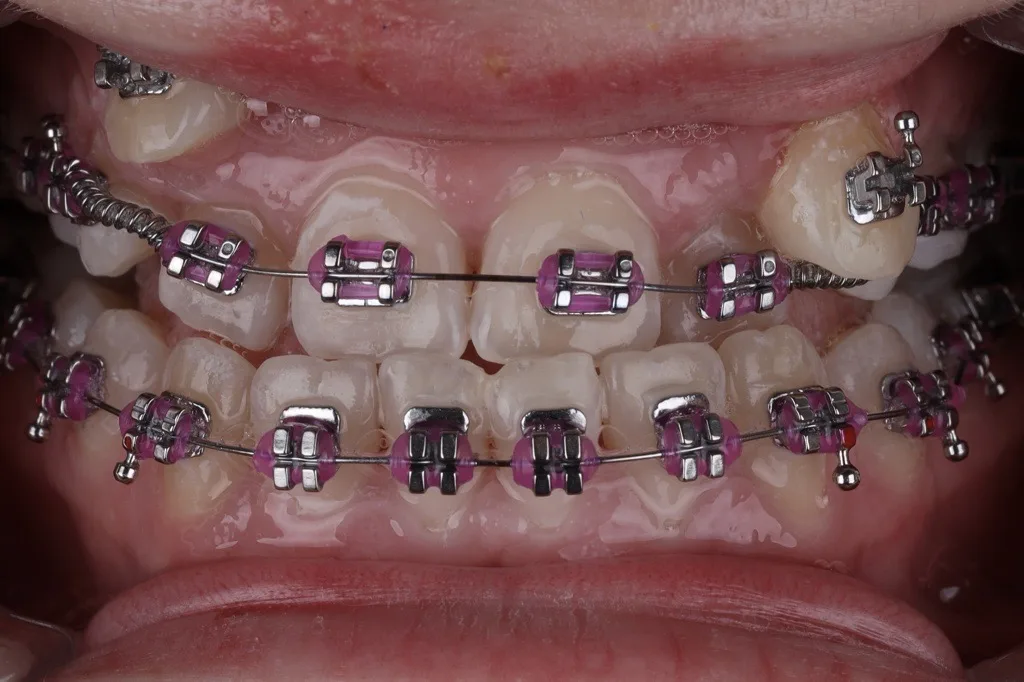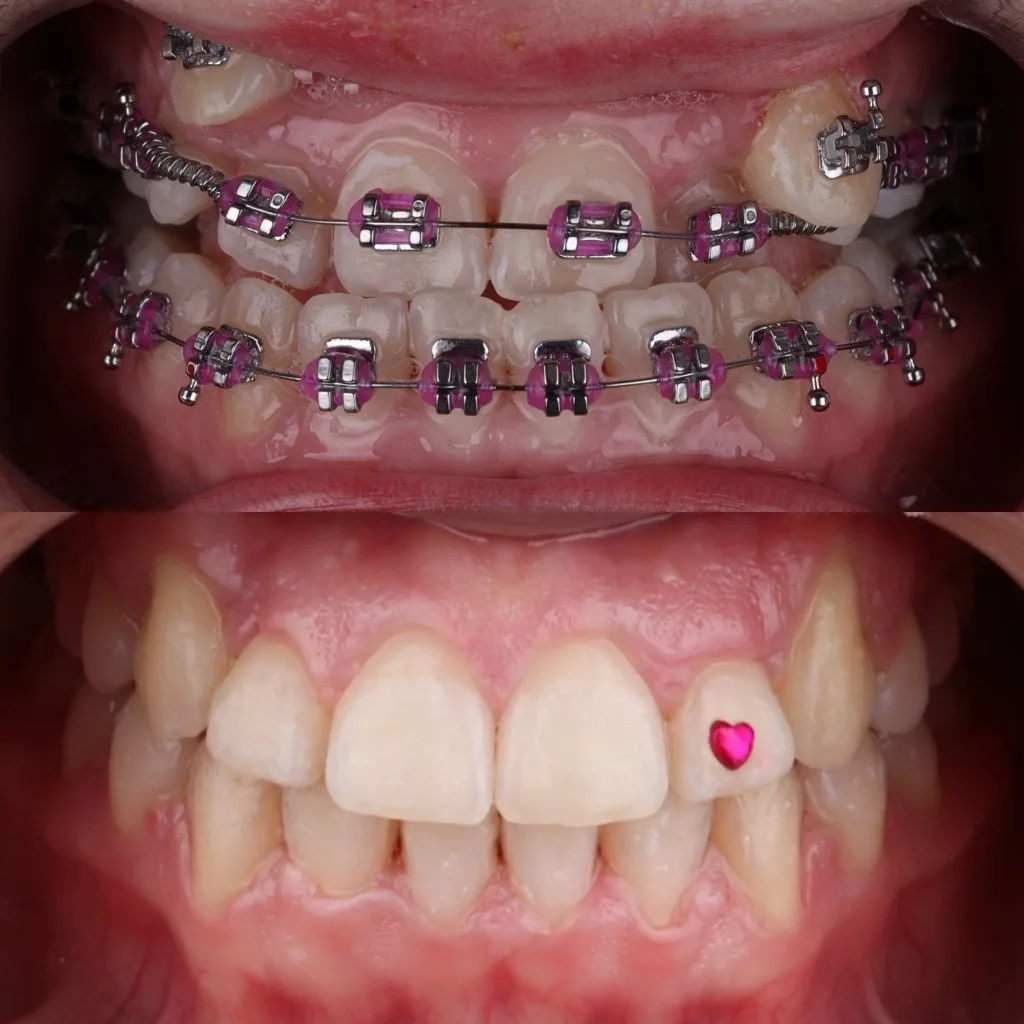Orthodontics is a branch of dentistry that focuses on the diagnosis, prevention, and treatment of misaligned teeth and jaws. At the core of this process are orthodontic braces, which gradually move teeth into the correct position and help correct bite problems.
At Saraj Dent clinic in Sarajevo, our experienced orthodontist helps patients achieve a healthy and beautiful smile through customized orthodontic treatment. Braces are not just an aesthetic solution – properly aligned teeth improve chewing function, protect gum and jaw joint health, and boost self-confidence.
In this guide, we explain the main types of orthodontic braces, their advantages and disadvantages, as well as practical tips for patients considering orthodontic treatment.
Why are orthodontic braces important?
Crooked or misaligned teeth (malocclusions) can cause a variety of problems:
- difficulties with chewing and speech,
- uneven tooth wear,
- higher risk of cavities and gum disease due to harder cleaning,
- pain in the temporomandibular joint (TMJ),
- aesthetic concerns and reduced self-esteem.
Orthodontic braces apply gentle, continuous forces to the teeth and jaws, gradually moving them into the desired position. Treatment usually lasts from several months to a few years, depending on the complexity of the case, patient’s age, and type of appliance.
Types of orthodontic braces
Modern orthodontics offers a wide range of solutions, but in general braces are divided into fixed and removable appliances.
1. Fixed orthodontic braces
Fixed braces are the most commonly used and provide the most precise results. They remain attached to the teeth throughout the entire treatment and cannot be removed by the patient.

They consist of brackets, wires, and other components. The main types are:
- Metal brackets – traditional, durable, and often the most affordable, but less discreet.
- Ceramic or aesthetic brackets – less visible, suitable for patients who prioritize appearance.
- Lingual braces – attached to the back of the teeth, completely hidden from view. Highly effective but require advanced expertise and are usually more expensive.
Advantages:
- highly effective for correcting even complex malocclusions,
- work 24/7,
- predictable results.
Disadvantages:
- more difficult oral hygiene,
- possible irritation of mouth tissues,
- longer adjustment period.
2. Removable orthodontic braces
Removable appliances can be taken out by the patient. They are often used in children during growth stages to guide jaw development, or as retention devices after fixed treatment.
Main types include:
- Traditional removable plates – acrylic appliances with wires and clasps, commonly used in children.
- Functional appliances – stimulate jaw growth and correct upper and lower jaw relationships.
- Clear aligners (e.g., Invisalign) – modern, nearly invisible plastic trays that are changed every few weeks. Very popular among adult patients in Sarajevo.
Advantages: easier oral hygiene and discreet appearance.
Disadvantage: success depends on patient compliance – if aligners or plates are not worn enough, results may be limited.
Special orthodontic appliances
In addition to standard braces, there are special appliances for specific cases:
- Palatal expanders – widen the upper jaw in children, creating space for proper tooth eruption.
- Retainers – worn after treatment to prevent teeth from shifting back.
- Mini dental implants (TADs) – small screws that help apply precise forces for complex movements.
These devices are an essential part of modern orthodontics, making treatment more effective and stable.
The orthodontic treatment process at Saraj Dent Sarajevo
1. First consultation & diagnostics – the orthodontist performs a clinical exam, takes impressions or digital scans, panoramic X-rays, and photos to create a personalized treatment plan.
2. Placement of braces – fixed braces are bonded to the teeth with wires; aligner patients receive a set of clear trays; children with removable devices get customized appliances.
3. Regular check-ups – usually every 4–6 weeks to adjust wires, change aligners, or monitor progress.
4. Retention phase – after achieving the desired result, retainers are worn to stabilize new tooth positions.
How long does orthodontic treatment last?
Duration depends on:
- complexity of the case,
- patient’s age,
- type of appliance,
- patient compliance.
On average, treatment lasts 12–24 months, though it can be shorter or longer. Early intervention in children is often recommended, while adult cases may take more time.
Oral hygiene during treatment
Braces create extra surfaces where food and plaque can build up, so maintaining oral hygiene is crucial.
Tips for patients:
- brush teeth after every meal,
- use orthodontic and interdental brushes,
- floss daily or use a water flosser,
- limit sweets and carbonated drinks,
- schedule regular professional cleanings.
Benefits of orthodontic treatment
Orthodontics is not only about aesthetics. Proper alignment brings many benefits:
- improved chewing and digestion,
- easier cleaning and reduced risk of cavities,
- less stress on teeth and jaws,
- reduced jaw joint pain,
- enhanced smile aesthetics and self-confidence.

Pain and discomfort
Most patients experience mild discomfort after braces are placed or adjusted, usually as tooth sensitivity, pressure, or mouth irritation. These symptoms are temporary and usually subside within a few days. Modern braces and protective waxes make treatment more comfortable than ever.
Orthodontic treatment cost in Sarajevo
The cost depends on:
- type of appliance (metal, ceramic, aligners, lingual),
- complexity of the case,
- treatment duration.
At Saraj Dent clinic in Sarajevo, prices are individualized, but orthodontics should be seen as a long-term investment in oral health and aesthetics. Braces provide lifelong benefits.
Myths about orthodontic braces
- “Braces are only for kids.” – False. More adults are getting braces with excellent results.
- “Braces damage teeth.” – Not true, as long as oral hygiene is maintained and check-ups are regular.
- “Treatment is always painful.” – Some discomfort is normal, but braces today are much more comfortable than before.
- “Results are temporary.” – With proper retention, results are permanent.
Conclusion
Orthodontic braces combine dental science and modern technology to improve not just appearance but also oral health and function.
At Saraj Dent clinic in Sarajevo, our orthodontist offers fixed braces, removable appliances, and clear aligners to help you achieve the smile you’ve always wanted.
Orthodontic treatment is a long-term investment in your health and confidence. If you are considering braces, the best first step is a consultation at Saraj Dent Sarajevo, where you will receive a personalized treatment plan and answers to all your questions.
